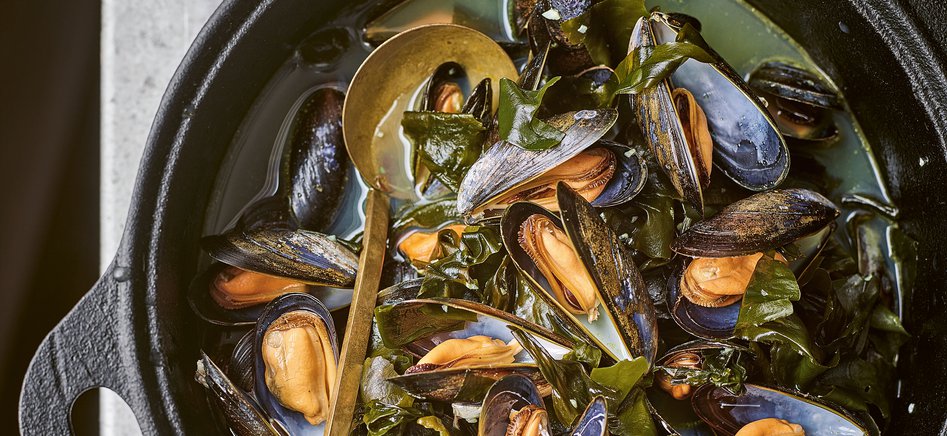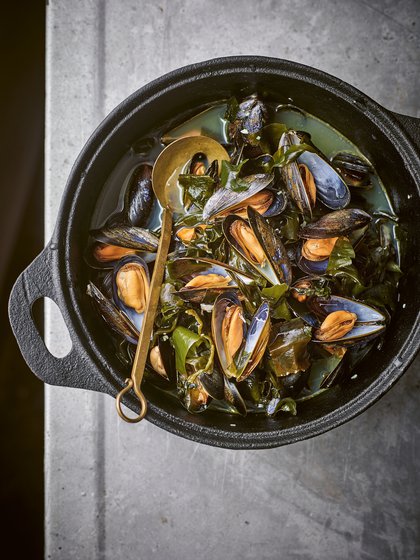Seaweed Soup with Mussels – or Birthday Soup

Honghap Miyeok Guk 홍합미역국
Recipe Source : Rice Table by Su Scott (Quadrille, £27), Photography by Toby Scott
This bowl of humble seaweed soup signifies birth. Seaweed, rich in minerals and vitamins, was traditionally given to mothers after a birth for its nutritional benefit. An old wives’ tale believed it increased milk production for nursing mothers as well as having healing properties. More traditionally, stock made from dried mussels was given to women for their first meal after labour, instead of more commonly eaten meat-based broths, to avoid any killing of livestock, in order to be respectful to the new life being born.
Tenderly braised seaweed in a delicately flavoured soup celebrates one’s mother for their hard labour. It is a small but symbolic gesture to remember the day with gratitude. Korean mothers take great pleasure in offering this soup for birthday breakfast to wish their child a long life in good health; a quiet display of a mother’s love, in a Korean way.
The Korean seaweed used in this soup, miyeok, is not dissimilar to wakame, brown algae commonly associated with Japanese cuisine. More typically, you will see versions with beef stock made from brisket as a base. However, mussels in season are particularly meaty and affordable. I find simple mussel broth not only much quicker to put together, but it also brings a subtly sweet ocean flavour which works really well with naturally salty seaweed.
I have opted to make the mussel broth separately, reserving the meat to add to the soup later. This process allows me to cook the seaweed in the broth for long enough to maximize the flavour of the soup without compromising the texture of the mussels. But by all means, you can simply reserve the mussels in their shells, with the meat still intact, and continue as instructed.

Ingredients
Serves 4
20g (3/4oz) miyeok (Korean seaweed)
500g (1lb 2oz) mussels, scrubbed and beards removed
1 litre (34fl oz/4 cups) just-boiled water
1 tbsp toasted sesame oil
1 tbsp vegetable oil
3 garlic cloves, minced
1 tbsp soup or light soy sauce
sea salt flakes, to taste
Method
- Soak the miyeok in plenty of cold water for 20 minutes. As it absorbs the water, it softens and blooms. Ensure the bowl is big enough to accommodate the volume of rehydrated seaweed.
- Discard any mussels that remain open and put the remainder in a large, lidded, heavy-based saucepan, along with the just-boiled water. Bring to the boil, then simmer gently for 10 minutes, or until the shells are opened. Discard any that remain closed. Have a large heatproof bowl or a jug ready and strain the stock through a fine sieve; it will appear translucent milky white. Reserve the stock. Remove the mussels from the shells and set aside. If you choose to keep the meat still intact in their shells, just simply set aside.
- Drain the seaweed and squeeze out the excess water. If using pre-cut, set aside. If using uncut, roughly chop it.
- Place a lidded, heavy-based saucepan over a low heat. Add both oils to the pan, along with the seaweed. Saut for 5 minutes, stirring from time to time. The seaweed should darken a little in colour. Stir in the garlic to soften, enough to smell the fragrant aroma.
- Pour the reserved mussel broth into the pan. Add the soy sauce. Bring to the boil, then simmer for 30 minutes. Add the reserved mussel meat and cook for 5 minutes to gently warm through. Remove from the heat. Check the seasoning and adjust with a touch more salt, if needed. Divide the soup into four bowls and serve with plain steamed rice.





